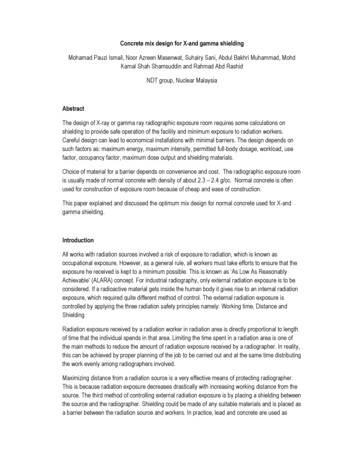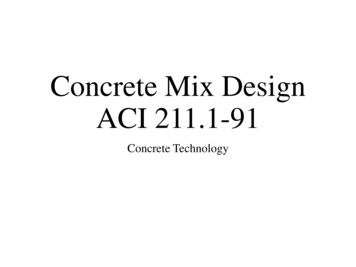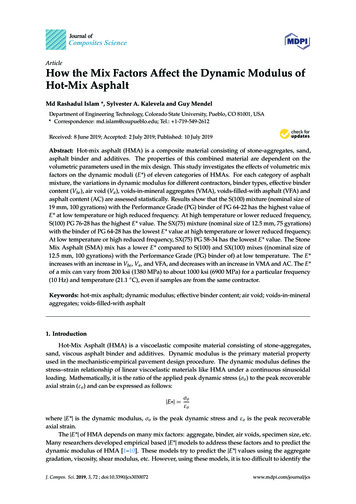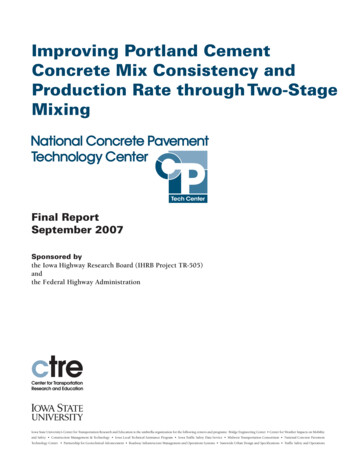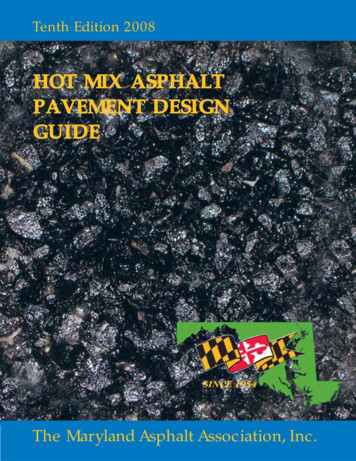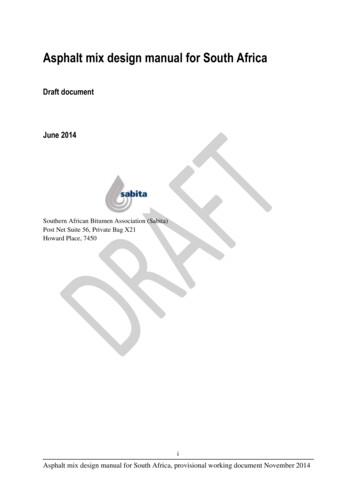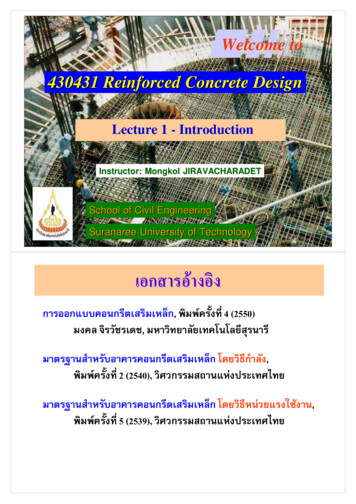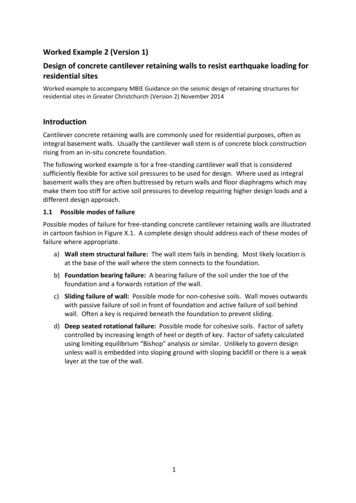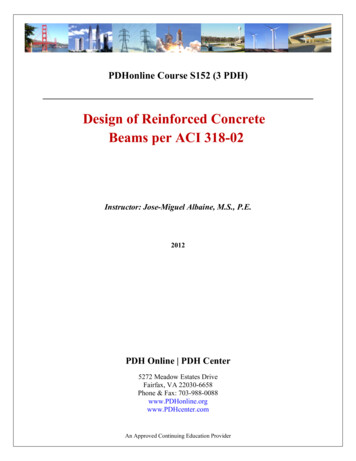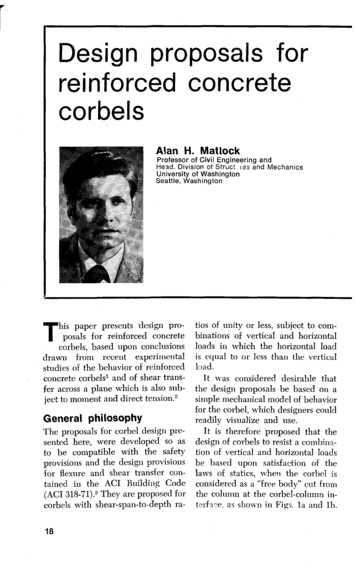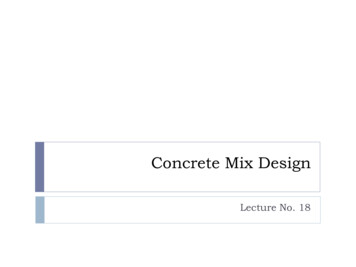
Transcription
Concrete Mix DesignLecture No. 18
Concrete Mix Design One of the ultimate aims of studying the various properties ofthe materials of concrete, plastic concrete and hardenedconcrete, is to enable a concrete technologist to design aconcrete mix for a particular strength and durability. The conditions that prevail at the site of work, in particularthe exposure condition, and the conditions that are demandedfor a particular work for which the mix is designed. Mix design can be defined as the process of selecting suitableingredients of concrete and determining their relativeproportions with the object of producing concrete of certainminimum strength and durability as economically as possible.
Concept of Mix Design The relationships between aggregate and paste which are thetwo essential ingredients of concrete. Workability of the mass is provided by the lubricating effect ofthe paste and is influenced by the amount and dilution ofpaste. The strength of concrete is limited by the strength of paste,since mineral aggregates with rare exceptions, are far strongerthan the paste compound. Essentially the permeability of concrete is governed by thequality and continuity of the paste, since little water flowsthrough aggregate either under pressure or by capillarity.
Concept of Mix Design Since the properties of concrete are governed to aconsiderable extent by the quality of paste, it is helpful toconsider more closely the structure of the paste. With the given materials, the four variable factors to beconsidered in connection with specifying a concrete mix are (a ) Water-Cement ratio (b ) Cement content or cement-aggregate ratio (c ) Gradation of the aggregates (d ) Consistency.
Various Methods of Proportioning Arbitrary proportion Indian Road Congress, IRC 44 method High strength concrete mix design Mix design based on flexural strength Road note No. 4 (Grading Curve method) ACI Committee 211 method DOE method Mix design for pumpable concrete Indian standard Recommended method IS 10262-82
Common Terminologies Mean strength: This is the average strength obtained by dividing the sum ofstrength of all the cubes by the number of cubes.𝑥𝑥 𝑛where x mean strengthΣx sum of the strength of cubesn number of cubes.
Common Terminologies Variance: This is the measure of variability or differencebetween any single observed data from the mean strength. Standard deviation: This is the root mean square deviation ofall the results. This is denoted by s or σ.𝜎 𝑥 𝑥𝑛 12where σ Standard deviation,n number of observationsx particular value of observationsx arithmetic mean.
Common Terminologies𝑥 804𝑥 𝑛20𝑥 40.2 𝑀𝑝𝑎𝜎 𝑥 𝑥𝑛 12359.20𝜎 20 1𝜎 4.34 𝑀𝑝𝑎
American Concrete Institute Method of MixDesign (ACI–211.1) This method of proportioning was first published in 1944 byACI committee 613. In 1954 the method was revised to include, among othermodifications, the use of entrained air. In 1970, the method of mix design became the responsibility ofACI committee 211. ACI committee 211 have further updated the method of 1991. Almost all of the major multipurpose concrete dams in Indiabuilt during 1950 have been designed by using then prevalentACI Committee method of mix design.
Step 01: Data to be collected Fineness modulus of selected F.A. Unit weight of dry rodded coarse aggregate. Sp. gravity of coarse and fine aggregates in SSD condition Absorption characteristics of both coarse and fine aggregates. Specific gravity of cement.Example:
Step 01: Data to be collected Design a concrete mix for construction of an elevated watertank. The specified design strength of concrete is 30 MPa at 28 daysmeasured on standard cylinders. The specific gravity of FA and C.A. are 2.65 and 2.7respectively. The dry rodded bulk density of C.A. is 1600 kg/m3, andfineness modulus of FA is 2.80. Ordinary Portland cement (Type I) will be used. C.A. is found to be absorptive to the extent of 1% and freesurface moisture in sand is found to be 2 per cent.
Step 02: Target Mean Strength Target Mean Strength 𝑓𝑚 𝑓𝑚𝑖𝑛 𝑘𝑠𝑓𝑚 𝑓𝑚𝑖𝑛 𝑘𝑠𝑓𝑚 30 1.65 𝑥 4.2𝑓𝑚 36.93 𝑀𝑃𝑎
Step 03: Water/cement ratio Find the water/cement ratio from the strength point of viewfrom Table 11.5. Find also the water/ cement ratio from durability point of viewfrom Table 11.6. Adopt lower value out of strengthdurability consideration. Since OPC is used, from table 11.5, the estimated w/c ratio is 0.47. From exposure condition Table11.6, the maximum w/c ratio is 0.50 Therefore, adopt w/c ratio of 0.47consideration and
Step 03: Water/cement ratio
Step 03: Water/cement ratio
Step 04: Maximum Size of Aggregate &Workability Decide maximum size of aggregate to be used. Generally forRCC work 20 mm and prestressed concrete 10 mm size areused. Decide workability in terms of slump for the type of job inhand. General guidance can be taken from table 11.7. Maximum size of aggregate 20 mm. Slump of concrete 50 mm
Step 04: Maximum Size of Aggregate &Workability
Step 05: Cement Content From Table 11.8, for a slump of 50 mm, 20 mm maximum sizeof aggregate, for non air- entrained concrete, the mixing water content is 185 kg/m3 of concrete. Also theapproximate entrapped air content is 2 per cent.185𝐶𝑒𝑚𝑒𝑛𝑡 𝐶𝑜𝑛𝑡𝑒𝑛𝑡 0.47𝐶𝑒𝑚𝑒𝑛𝑡 𝐶𝑜𝑛𝑡𝑒𝑛𝑡 394.0 𝑘𝑔 𝑚3
Step 05: Cement Content
Step 06: Weight of Coarse Aggregate From table 11.4 the bulk volume of dry rodded coarseaggregate per unit volume of concrete is selected, for theparticular maximum size of coarse aggregate and finenessmodulus of fine aggregate. The weight of C.A. per cubic meter of concrete is calculatedby multiplying the bulk volume with bulk density. From Table 11.4, for 20 mm coarse aggregate, for finenessmodulus of 2.80, the dry rodded bulk volume of C.A. is 0.62per unit volume of concrete.The weight of C. A. 0.62 𝑥 1600 992.0 𝑘𝑔 𝑚3
Step 06: Weight of Coarse Aggregate
Step 07: Weight of Fine Aggregate From Table 11.9, the first estimate of density of fresh concretefor 20 mm maximum size of aggregate and for non-airentrained concrete 2355 kg/m3 The weight of all the known ingredient of concrete Weight of water 185 kg/m3 Weight of cement 394 kg.m3 Weight of C.A. 992 kg/m3Weight of F. A. 2355 – (185 394 992) 784.0 𝑘𝑔 𝑚3
Step 07: Weight of Fine Aggregate
Step 07: Weight of Fine Aggregate From Table 11.9, the first estimate of density of fresh concretefor 20 mm maximum size of aggregate and for non-airentrained concrete 2355 kg/m3 Alternatively the weight of F.A. can also be found out byabsolute volume method which is more accurate, as follows.
Step 07: Weight of Fine AggregateItemIngredientsWeightAbsolute volume1CementFrom Step 5Weight of Cement 10 3 Sp. gravity of Cement2WaterFrom Step 4Weight of Water 103 Sp. gravity of Water 10 33Coarse AggregateFrom Step 6Weight of C.A. 103 Sp. gravity of C.A. 1034Air% of Air Voids 10 6 100 103---Total absolute volume 10 3
Step 07: Weight of Fine AggregateTotal absolute volume 697.0 x 103 cm3Therefore absolute volume of F.A. (1000 – 697) x 103 303.0 x 103Weight of FA 303 x 2.65 803.0 kg m3
Step 08: regateWaterChemicalQuantity𝑘𝑔 1 BagCement50.0102.0126.023.5NM
Step 09: Adjustment for Field Condition The proportions are required to be adjusted for the fieldconditions. Fine Aggregate has surface moisture of 2 %2Weight of F. A. 803.0 803.0100 819.06 kg m3 Course Aggregate absorbs 1% water1Weight of F. A. 992.0 992.0100 982.0 kg m3
Step 10: Final Design regateWaterChemicalQuantity𝑘𝑔 1 BagCement50.0104.0124.523.5NM
ACI committee 613. In 1954 the method was revised to include, among other modifications, the use of entrained air. In 1970, the method of mix design became the responsibility of ACI committee 211. ACI committee 211 have further updated the method of 1991. Almost all of
